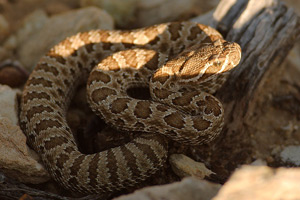|
|

It's a warm autumn day in Billings. The city stretches out towards farms and ranches bathed in shades of gold and green. We pass fields with old barns and outbuildings, leaning with age. A hand-painted sign on a fence announces "Apples." Horses are scattered everywhere.
As we near Lovell, Wyoming, the land becomes dryer, rockier. Oil pumps, mixed in with grazing cattle, conflict with the serene landscape. The Pryor Mountains rise to our east. We turn down an old dirt road and head towards them, winding around a mostly dry creek. It is slow, tedious driving; the kind of driving that brings up doubts about directions. But although we lose track of the miles, we find the right turn-off and enter the Pryor Mountain Wild Horse Refuge.

The road up to the mountains is worse than rough; it's like driving up a narrow dry, rocky gulch. Tough work even for a jeep. We stop at Sykes Coulee Enclosure and hike around, looking for wild horses. The high desert overlooking the canyon exudes its own special beauty in reds and oranges and fading green. A baby rattle snake curls under a rock. It is very quiet up here, almost silent. We see some horse sign, but no horses and the sun is beginning to set. The horses must be farther up.
The drive back down is as bad as the drive up. We are grateful to reach the dirt road and notice horses grazing within fences, some with unusual colors. These horses are on private land, but may have been bred with mustangs. One in particular was striking, with a black face and ears, melting over his withers to a speckled body and a black mane, black socks and tail. And another, a butter colored palomino.
We pass a small herd of deer grazing in an empty pasture in front of a ranch house when we are startled by an albino deer in the middle of the herd. She is a completely white version of the does surrounding her. A first for us - I have never seen an albino animal.
It's slowly getting darker, but we drive up the highway into the wild horse range anyway. Grazing alone not far from the road is a black horse. His tail is long and his mane is shaggy. Our first wild horse. Farther up the road to the west we see other horses grazing, but they are hard to see in the evening shadows. Still, we were encouraged.
Author - Christine Baleshta
Photography - Tim Springer
 |
Click for larger image
|
|

